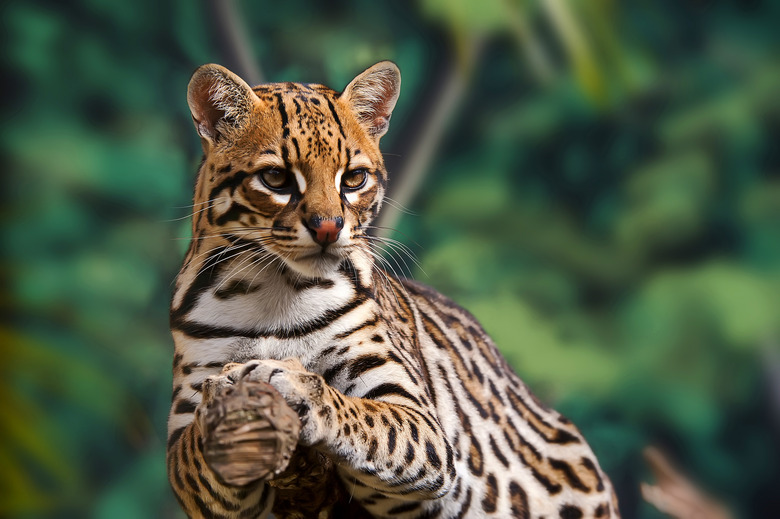Adaptations Of Animals In The Tropical Rain Forest
With warm temperatures, water and an abundance of food, tropical rain forests support thousands of wildlife species. The competition means organisms must adapt or develop specialized traits to compete for environmental resources. Many rain forest animals use adaptations to carve out their own niches and protect themselves from predators.
Crafty Camouflage
Crafty Camouflage
Being invisible to a predator or to prey is an advantage in the tropical rain forest. One animal – the sloth – combines expert cover with slow-motion movement to dodge predators such as the jaguar. A sloth's fur is covered with green algae so it blends with the environment. It is the world's slowest moving animal and takes up to a month to digest its food, so it doesn't need many resources to survive. The boa constrictor uses its camouflaged invisibility to sneak up on prey, while tiny rain forest grasshoppers have developed near-transparent coloring to blend in with leaves.
Prime Real Estate
Prime Real Estate
The ground floor and lower canopies of the rain forest bustle with wildlife. The aptly named spider monkeys have adapted to live at the top of the tree canopy where they have little competition for food. The spider monkey's prehensile tail gives it the ability to swing gracefully from tree to tree. Sloths also live in the trees, preferring to spend the day hanging upside down from branches. Their propensity for slow movement attests to the lack of predators they face.
Picky Eaters
Picky Eaters
Some animals in the rain forest have adapted to a limited diet so they don't face competition for food. Toucans snag hard-to-reach fruit – inaccessible to other feathered flyers – with their long, narrow beaks. Parrots have incredibly sturdy bills to crack nuts and dig out hidden food. Leaf cutter ants put in a hard day's work for a meal. They carry bits of leaves 50 times their weight from high branches to the ground. They bury the leaves and eat the fungus that grows as the plant matter decomposes.
Danger, Danger
Danger, Danger
Rain forest animals and insects often use bright coloring and distinctive markings to scare predators. Some of these creatures, such as certain species os poison dart frogs, actually are dangerous, but some aren't. They merely assume the appearances of dangerous animals. For example, some species of dart frogs aren't poisonous at all; they adapted to mimic their relatives' poisonous nature. Another example is the completely benign lobster moth, whose larva looks like a scorpion. Moths aren't dangerous, but many have markings on the wings that resemble eyes, and those are usually enough to keep them safe.
Size and Stature
Size and Stature
Large animals, like lions and elephants, live on the plains for good reason. Size is no advantage in the rain forest where a dense understory makes movement difficult. Jaguars are the largest cats in the rainforest, but they seldom grow to more than six feet in length and weigh more than 200 pounds. The small size and stocky build give them the speed and strength they need to hunt small prey that live in trees. Snakes, on the other hand, can grow larger in the rainforest than elsewhere because of their ability to slither along the ground and through trees. Reaching lengths of 20 to 30 feet and weights of over 500 pounds, anacondas are the world's largest snakes.
Creatures of the Night
Creatures of the Night
When the sun goes down, some animals bed down. Others – including the flying fox bat, the leopard cat and Wallace's flying frog – are bright-eyed and on the lookout for a meal. The adaptation to night hunting gives nocturnal animals the benefit of reduced competition for food. At night, there are no birds to compete for the fruit and blossoms that form the diet for flying fox bats or the insects that flying frogs prefer. Leopard cats eat lizards, insects amphibians and other small animals – including flying foxes and flying frogs, if they can catch them. Many of the animals that form the diet for these 10-pound feline predators are also active at night.
Cite This Article
MLA
Robbins, Carolyn. "Adaptations Of Animals In The Tropical Rain Forest" sciencing.com, https://www.sciencing.com/adaptations-animals-tropical-rainforest-6862950/. 9 March 2018.
APA
Robbins, Carolyn. (2018, March 9). Adaptations Of Animals In The Tropical Rain Forest. sciencing.com. Retrieved from https://www.sciencing.com/adaptations-animals-tropical-rainforest-6862950/
Chicago
Robbins, Carolyn. Adaptations Of Animals In The Tropical Rain Forest last modified March 24, 2022. https://www.sciencing.com/adaptations-animals-tropical-rainforest-6862950/
